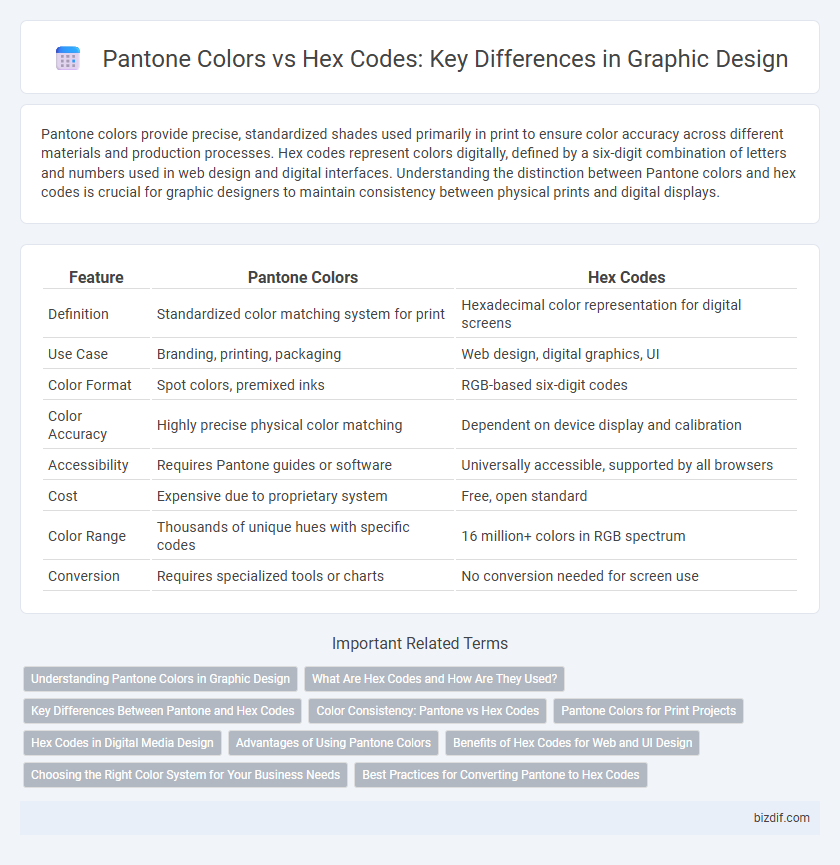Pantone colors provide precise, standardized shades used primarily in print to ensure color accuracy across different materials and production processes. Hex codes represent colors digitally, defined by a six-digit combination of letters and numbers used in web design and digital interfaces. Understanding the distinction between Pantone colors and hex codes is crucial for graphic designers to maintain consistency between physical prints and digital displays.
Table of Comparison
| Feature | Pantone Colors | Hex Codes |
|---|---|---|
| Definition | Standardized color matching system for print | Hexadecimal color representation for digital screens |
| Use Case | Branding, printing, packaging | Web design, digital graphics, UI |
| Color Format | Spot colors, premixed inks | RGB-based six-digit codes |
| Color Accuracy | Highly precise physical color matching | Dependent on device display and calibration |
| Accessibility | Requires Pantone guides or software | Universally accessible, supported by all browsers |
| Cost | Expensive due to proprietary system | Free, open standard |
| Color Range | Thousands of unique hues with specific codes | 16 million+ colors in RGB spectrum |
| Conversion | Requires specialized tools or charts | No conversion needed for screen use |
Understanding Pantone Colors in Graphic Design
Pantone colors are standardized color swatches used in graphic design to ensure color consistency across various printing processes and materials. Unlike hex codes, which represent colors digitally in RGB format, Pantone colors provide precise color matching, critical for brand identity and print production accuracy. Designers rely on the Pantone Matching System (PMS) to communicate exact hues that might vary when reproduced on different printers or substrates.
What Are Hex Codes and How Are They Used?
Hex codes are six-digit alphanumeric values representing specific colors in digital design, structured as #RRGGBB to indicate red, green, and blue components. They are essential in web development and graphic design for ensuring color consistency across digital platforms and are widely used in CSS and HTML coding. Hex codes provide precise control over color selection, enabling designers to achieve exact hues for branding, user interfaces, and digital artwork.
Key Differences Between Pantone and Hex Codes
Pantone colors are standardized spot colors used in print production, ensuring consistent and accurate color matching across different materials and printers, while Hex codes represent digital colors in web design through six-digit hexadecimal values corresponding to RGB color mixes. Pantone relies on physical color swatches and specific ink formulations for precise reproduction, whereas Hex codes are device-dependent and vary based on screen displays and color profiles. The key difference lies in Pantone's suitability for physical, tangible mediums versus Hex codes' optimization for digital environments and online graphics.
Color Consistency: Pantone vs Hex Codes
Pantone colors provide precise, standardized color matching across different materials and devices, ensuring consistent visual identity for branding and print projects. Hex codes, used primarily in digital design, can vary in appearance depending on screen calibration, lighting, and browser rendering, leading to potential inconsistencies. Accurate color reproduction is more reliably achieved with Pantone systems in physical media, whereas Hex codes are ideal for web and digital interfaces.
Pantone Colors for Print Projects
Pantone colors provide precise, standardized color matching essential for print projects, ensuring consistency across different printers and materials. Unlike hex codes, which are digital representations designed for screens, Pantone colors are formulated with specific inks that achieve exact hues in physical printing. This reliability makes Pantone the preferred choice for branding and print work where color accuracy is critical.
Hex Codes in Digital Media Design
Hex codes serve as the universal standard for representing colors in digital media design, providing precise color values through a six-digit combination of numbers and letters that define red, green, and blue components. Unlike Pantone colors, which are primarily used for print and physical color matching, hex codes ensure consistent color rendering across various digital devices and web browsers. This predictability makes hex codes essential for web design, app interfaces, and online branding where exact digital color reproduction is crucial.
Advantages of Using Pantone Colors
Pantone colors ensure precise color matching across various materials and print processes, eliminating inconsistencies that often occur with hex codes on digital screens. Their standardized system provides designers and manufacturers with a universal color language, enhancing brand identity and color accuracy in packaging, textiles, and print media. Pantone colors also offer extensive color durability and vibrancy, which digital displays using hex codes cannot replicate consistently.
Benefits of Hex Codes for Web and UI Design
Hex codes offer precise color representation that ensures consistent display across various digital devices, which is crucial for web and UI design accuracy. These six-character alphanumeric codes allow seamless integration with CSS and HTML, facilitating efficient coding and quick color adjustments. Unlike Pantone colors, hex codes are universally supported in digital environments, optimizing brand consistency and user interface aesthetics on screens.
Choosing the Right Color System for Your Business Needs
Pantone colors offer precise, standardized hues essential for consistent brand identity across physical products, while hex codes are optimized for digital displays and web design. Choosing between Pantone and hex depends on your business's primary medium: print materials require Pantone for accuracy, whereas online platforms benefit from the flexibility and scalability of hex codes. Evaluating your target audience's consumption habits and production methods ensures the selected color system aligns with your branding and marketing goals.
Best Practices for Converting Pantone to Hex Codes
When converting Pantone colors to Hex codes, prioritize accurate color matching by referencing updated Pantone color guides and trusted conversion tools to ensure consistency across digital and print media. Use calibrated monitors and color management software to verify that the Hex values closely replicate the intended Pantone shades, maintaining brand integrity in web design. Always consider the color model differences--Pantone being spot color and Hex based on RGB values--adjusting for lighting conditions and display variations to achieve the best visual fidelity.
Pantone Colors vs Hex Codes Infographic

 bizdif.com
bizdif.com